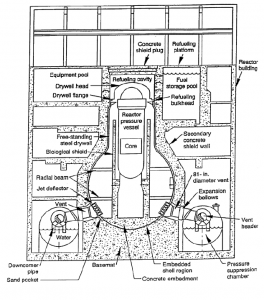The Fukushima I Nuclear Power Plant experienced the earthquakes and flooding of the past few days. The nuclear reactors shut down automatically after the earthquake, but the subsequent flooding and loss of power via emergency generator flooding has caused loss of control of the reactors. The sketch below provides a bit of insight into the Fukushima reactors:

As I tried to understand the crisis, here are a few things I learned.
- Are the various explosions nuclear explosions? No, the exposed (due to lack of cooling water) metal fuel rods react with the steam to produce hydrogen. The reactors are designed for that hydrogen to burn off prior to explosive levels being reached, but the lack of electricity probably kept that system from functioning. Therefore, the hydrogen concentration increased then exploded (think Hindenburg).
- Did those explosions crack the containment vessels? It appears the containment vessels (prestressed concrete several feet thick with a steel core) has not been damaged by the hydrogen explosion. The upper building shell (mainly in place to keep weather off the reactor) was damaged.
- Why is Reactor #3 the most critical? There are 6 reactors, but only #3 uses plutonium as a fuel. The byproducts of the plutonium reactor are much more carcinogenic than from the other five.
- How much radiation has actually been released? The levels at the plant were around 751 microsieverts, a dosage similar to a stomach x-ray. A fatal dose of radiation would be more than 7 million microsieverts. The Japanese authorities are instructing nearby residents to stay indoors and are distributing potassium iodine pills to prevent radiation from building up in the thyroid (the most dangerous aspect of nuclear fallout). One resident commented, “My house was washed away by the tsunami, now the government tells me to stay indoors.”
- What is a meltdown? Actually, the term meltdown isn’t used in industry codes or documentation. The media uses that term, but it doesn’t have a precise industry definition. Generally, though, a meltdown would be the nuclear fuel rods creating some much heat as to melt through the steel and concrete core liner.
- Will the containment structures be breached (meltdown)? Each day seems to bring some good news and some bad news. As of today, it’s possible each of the 6 reactors will be adequately cooled with ocean water or their normal cooling water and prevent further damage. It’s also possible (though I think much less likely) that the cooling systems will fail and a meltdown will occur.
Update on March 19, 2011: It appears Reactors #1, 2 and 3 are currently stable (though with damaged cores), with sea water being pumped into them via fire hoses. The helicopters dropping water and water cannons spraying flumes were creative but unsuccessful efforts. Reactor #4 seems to be most at risk, with little data available about the current condition. The life threatening work performed by the plant workers inspires me. What great honor and courage!
I’ll update as seems appropriate.
